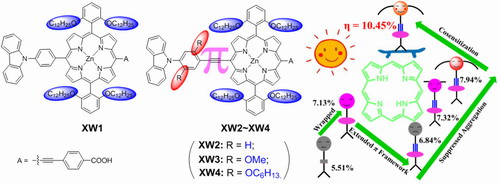Recently, Prof. Xie Yongshu Group achieved significant advance in Dye-sensitized Solar Cells (DSSCs). A paper entitled “Efficient Solar Cells Sensitized by Porphyrins with Extended Conjugation Framework and a Carbazole Donor: from Molecular Design to Cosensitization” was published in Angew. Chem. Int. Ed. (http://dx.doi.org/10.1002/anie.201406190). The research work was mainly performed by a doctoral student Yueqiang Wang under the direction of Prof. Yongshu Xie.
One of the important approaches for utilizing solar energy is converting it to electric energy. Thus, DSSCs have been widely investigated because of their low production cost, easy fabrication and relatively high solar energy conversion efficiency. In recent years, continuous efforts have been devoted to improving the cell efficiencies. In this respect, porphyrins have strongly absorbing bands and easily tuned chemical structures, and thus demonstrate unique advantages in light harvesting and energy conversion. However, porphyrin dyes show weak absorption in the near-infrared region and around 500 nm. To address this problem, an additional ethynylene bridge was inserted between the donor and the porphyrin framework to extend the absorption wavelength range to longer wavelengths, and then methoxy or hexyloxy groups were introduced to the phenylene group neighbouring to the donor to suppress the adverse dye aggregation associated with the ethynylene bridge. Finally, a non-porphyrin organic dye with a high open voltage and strong absorption around 500 nm was used as the cosensitizer, which significantly enhanced the current density and slightly enhanced the open voltage, thus achieving the highest cell efficiency of 10.45%. In addition, carbazole was used as the donor group in this work, which breaks the limitation of using diphenylamine as the donor group in most highly efficient porphyrin dyes, and thus demonstrates the opportunities of developing effective porphyrin sensitizers by employing electron donors other than diphenylamine.

The accomplishment of this work benefits from the excellent scientific research atmosphere and long-term accumulation in the field of DSSCs in Academician Tian He group. This work was financially supported by NSFC/China (21072060, 91227201), the Oriental Scholarship, NCET-11-0638, and the Fundamental Research Funds for the Central Universities (WK1013002).




